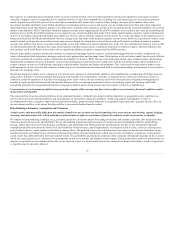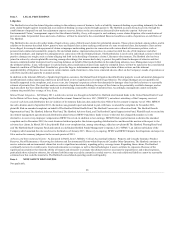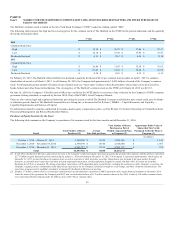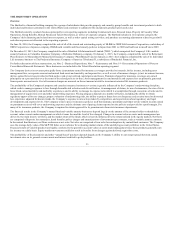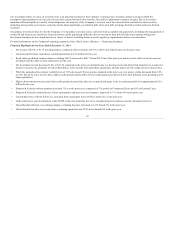The Hartford 2014 Annual Report Download - page 24
Download and view the complete annual report
Please find page 24 of the 2014 The Hartford annual report below. You can navigate through the pages in the report by either clicking on the pages listed below, or by using the keyword search tool below to find specific information within the annual report.
Further, because these laws and regulations are complex and sometimes inexact, there is also a risk that our business may not fully comply with a particular
regulator's or enforcement authority's interpretation of a legal, accounting, or reserving issue or that such regulator’s or enforcement authority’s interpretation
may change over time to our detriment, or expose us to different or additional regulatory risks. The application of these regulations and guidelines by
insurers involves interpretations and judgments that may not be consistent with the opinion of state insurance departments. We cannot provide assurance that
such differences of opinion will not result in regulatory, tax or other challenges to the actions we have taken to date. The result of those potential challenges
could require us to increase levels of statutory capital and reserves or incur higher operating and/or tax costs.
In addition, our international operations are subject to regulation in the relevant jurisdictions in which they operate which in many ways is similar to the state
regulation outlined above, with similar related restrictions and obligations. Our asset management businesses are also subject to extensive regulation in the
various jurisdictions where they operate.
These laws and regulations are primarily intended to protect investors in the securities markets or investment advisory clients and generally grant supervisory
authorities broad administrative powers. Compliance with these laws and regulations is costly, time consuming and personnel intensive, and may have an
adverse effect on our business, financial condition, results of operations and liquidity. See the risk factor, “The impact of regulatory initiatives, including the
enactment of The Dodd-Frank Wall Street Reform and Consumer Protection Act of 2010, could have a material adverse impact on our business, financial
condition, results of operations and liquidity.”
Changes in federal or state tax laws could adversely affect our business, financial condition, results of operations and liquidity.
Changes in federal or state tax laws could have a material adverse effect on our profitability and financial condition, and could result in our incurring
materially higher corporate taxes. Higher tax rates may cause small businesses to hire fewer workers and decrease investment in their businesses, including
purchasing vehicles, property and equipment, which could adversely affect our business, financial condition, results of operations and liquidity. Conversely,
if income tax rates decline it could adversely affect the Company's ability to realize the benefits of its deferred tax assets.
In addition, the Company’s tax return reflects certain items, including but not limited to, tax-exempt bond interest, dividends received deductions, tax credits
(such as foreign tax credits), and insurance reserve deductions. There is an increasing risk that, in the context of deficit reduction or overall tax reform, federal
and/or state tax legislation could modify or eliminate these items, impacting the Company, its investments, investment strategies, and/or its policyholders.
Although the specific form of any such legislation is uncertain, changes to the taxation of municipal bond interest could materially and adversely impact the
value of those bonds, limit our investment choices and depress portfolio yield. Elimination of the dividends received deduction or changes to the taxation of
reserving methodologies for P&C companies could increase the Company’s actual tax rate, thereby reducing earnings. Moreover, many of the products that
the Company previously sold benefit from one or more forms of tax-favored status under current federal and state income tax regimes. For example, the
Company previously sold annuity contracts that allowed policyholders to defer the recognition of taxable income earned within the contract. Because the
Company no longer sells these products, changes in the future taxation of life insurance and/or annuity contracts will not adversely impact future sales. If,
however, the treatment of earnings accrued inside an annuity contract was changed prospectively, and the tax-favored status of existing contracts was
grandfathered, holders of existing contracts would be less likely to surrender, which would make running off our existing annuity business more difficult.
Regulatory requirements could delay, deter or prevent a takeover attempt that shareholders might consider in their best interests.
Before a person can acquire control of a U.S. insurance company, prior written approval must be obtained from the insurance commissioner of the state where
the domestic insurer is domiciled. Prior to granting approval of an application to acquire control of a domestic insurer, the state insurance commissioner will
consider such factors as the financial strength of the applicant, the acquirer's plans for the future operations of the domestic insurer, and any such additional
information as the insurance commissioner may deem necessary or appropriate for the protection of policyholders or in the public interest. Generally, state
statutes provide that control over a domestic insurer is presumed to exist if any person, directly or indirectly, owns, controls, holds with the power to vote, or
holds proxies representing 10 percent or more of the voting securities of the domestic insurer or its parent company. Because a person acquiring 10 percent or
more of our Common Stock would indirectly control the same percentage of the stock of our U.S. insurance subsidiaries, the insurance change of control laws
of various U.S. jurisdictions would likely apply to such a transaction. Other laws or required approvals pertaining to one or more of our existing subsidiaries,
or a future subsidiary, may contain similar or additional restrictions on the acquisition of control of the Company. These laws may discourage potential
acquisition proposals and may delay, deter, or prevent a change of control, including transactions that our Board of Directors and some or all of our
shareholders might consider to be desirable.
24



